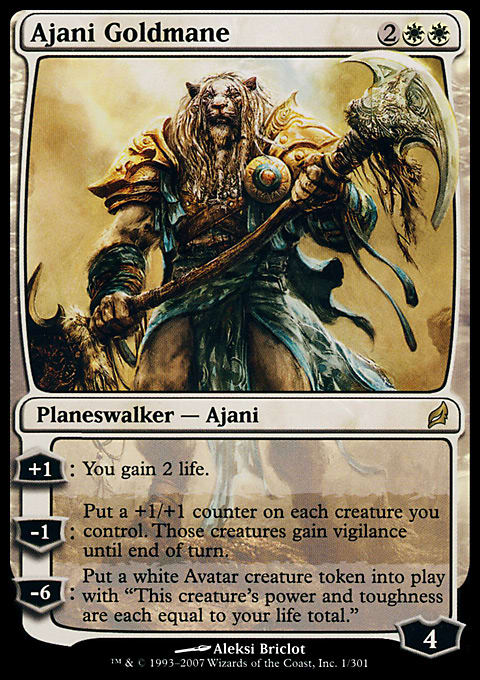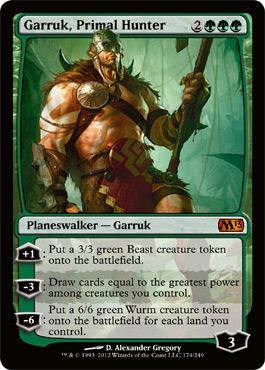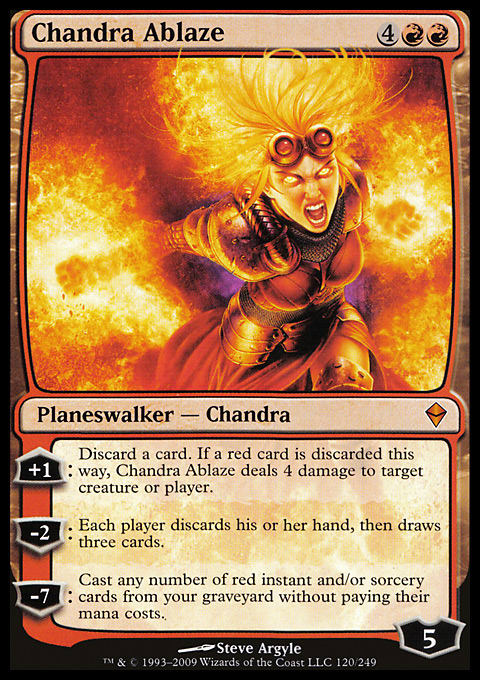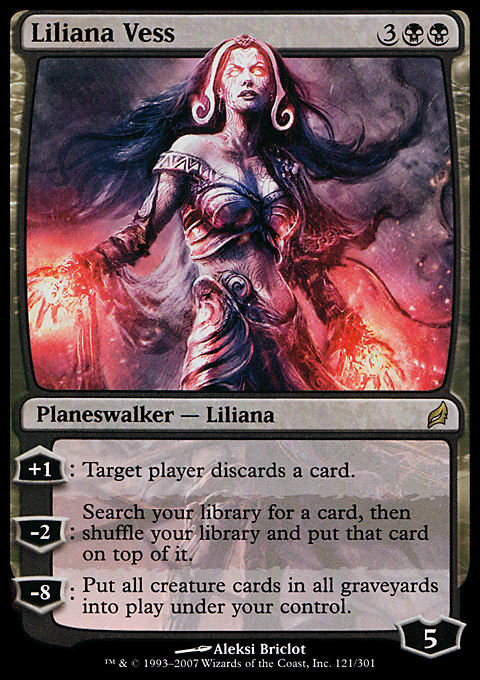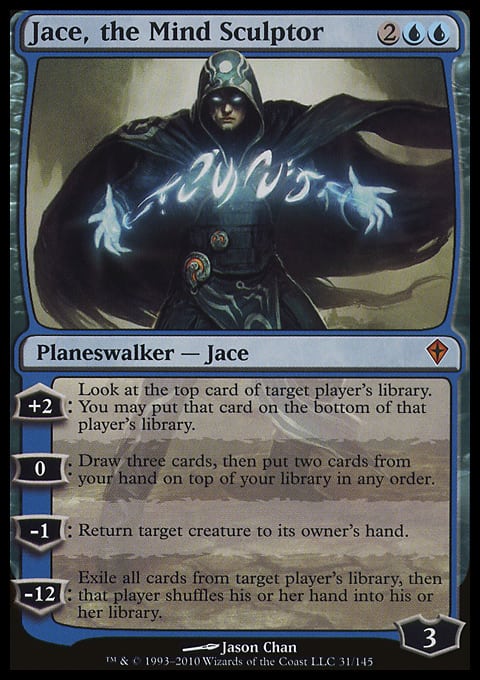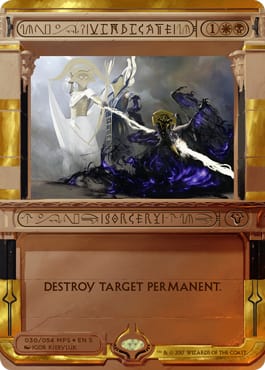It’s Planeswalker Week here on GatheringMagic, with Jules, Brandon, and Brendan looking at the most powerful and complex beings in the multiverse from all angles, and I couldn’t let that happen without putting the multiplayer perspective front and center. Today, we’re going to look at all of the planeswalkers in our arsenal, how to think about their different abilities, and how to deal with our opponents’ planeswalkers.
Cast of Characters
Planeswalkers have only been with us since 2007—five blocks in Magic time. Players who started since Lorwyn have never known a time when Magic didn’t have planeswalkers, but for a lot of us, they're still these newfangled contraptions, and things were better when we had to walk to school in the snow, uphill both ways.
Even in a relatively short time, we have seen so much variety in planeswalkers that it’s important to look at them individually rather than lumping them all together and generalizing about them. So, here are the successive generations of planeswalkers:
Lorwyn
Alara
Zendikar
Magic 2012
Mirrodin/Phyrexia
Innistrad
- Garruk Relentless
- Liliana of the Veil
- Sorin, Lord of Innistrad
- Tamiyo, the Moon Sage
- Tibalt, the Fiend-Blooded
Magic 2013
Those are some of the most powerful spells in the game, but their value in multiplayer has been hotly debated. If I may step on Jules’s toes for a second, it seems apparent that few if any planeswalkers were designed with multiplayer in mind. For example, Jace 1.0 (and potentially 3.0) draws everybody a card, Liliana 2.0 can make everyone at the table discard, Chandra 2.0 spins the wheel for everyone, and Karn starts the game for all players. However, some planeswalker abilities do scale for multiplayer to some extent. Liliana 1.0 and Tibalt can usually give you control of more critters in a multiplayer game than a duel, and Elspeth 2.0 will blow up more stuff for the same reason. And while they don’t exactly scale, Garruk 2.0’s army of Wurm tokens, Tamiyo’s looping, Liliana 3.0’s mana ramping, and Elspeth 1.0’s indestructibility all seem stronger in a longer game against multiple threats.
Still, the fact remains that we haven't seen a truly multiplayer-oriented planeswalker yet.
The Value of Planeswalkers
Planeswalkers are strong for a couple of reasons:- Individual abilities
- Versatility
- Repeatability
- Damage deflection
Obviously, planeswalkers have abilities and those abilities can be useful; otherwise, I wouldn’t be writing this, and you wouldn’t be reading it. But for all the times when you might only use a planeswalker once before it’s ganked, those individual abilities might seem weak—or at least over-costed. Duress for 1 mana is usually better than paying 5 mana to get one card out of a single opponent’s hand with Liliana Vess, and Diabolic Tutor for 4 is better than having one shot of her Vampiric Tutor effect.
But planeswalkers usually offer two or three playable abilities, and being able to choose which effect to use is huge. For example, Garruk Wildspeaker is an awesome ramp spell for 4 mana, and that’s the main reason I use him in my Kresh deck. In fact, I’m happy to untap lands with him all day—Kresh rarely needs an Overrun effect to put the game away. On the other hand, when you're behind the eight ball, you may be happy to play him to make three chump-blockers, and weenie decks may well depend on his ultimate to punch through against an opponent’s better creatures. Most planeswalkers offer something useful at each stage of the game, and they are rarely dead draws.
Third, planeswalkers are cockroach cards,1 and the repeatability of their effects is a huge part of what makes them so valuable. How many cards is someone going to draw over the course of a game if he can keep a Jace on the table? Even if Sorin Markov never hits his ultimate, he can slaughter every weenie on the table; against some decks, that can be a decisive advantage. And cards like Elspeth and the various iterations of Garruk can churn out enough tokens to swing the game even if they're never more than pathetic vanilla chumps.
Fourth and finally, planeswalkers will often soak up far more damage than anyone realizes. If I cast Liliana Vess and tutor with her once before she dies, is that a waste of time? Hell no! The damage that was done to her was not done to me, and that is often more than enough to decide the game in my favor.
This aspect of planeswalkers is often overlooked, so it’s worth looking at in a little more depth. Recently, I had Liliana 1.0 up to 7 counters in a Three-Headed Giant Commander game before she was trampled to death by a 14/14 Omnath, Locus of Mana and two Primeval Titans; that made her a virtual Time Walk in addition to a poor man’s Imperial Seal. If my opponents had only swung at her with Omnath, I would have put my Mulldrifter in the way and tried to take her ultimate, but when they swung with everything, the writing was on the wall. In that situation, I happily let it all through and used the tempo advantage of their almost-wasted attack step to win the game.
When planeswalkers soak up damage, they can also force your opponents to overextend their attacks. That gives you a lot of opportunities for profitable blocks. A Primeval Titan won’t normally swing into an Acidic Slime, but if it’s the only way to stop Nicol Bolas, Planeswalker from stealing the Titan—or even going ultimate—the opponent will take that chance, and you can happily trade your Slime for his best creature. In most cases, you can usually generate at least a little bit of card advantage (or card quality) from defending your planeswalker against attack—even if it ends up being killed.
In a duel, conventional wisdom says that if you get a planeswalker to go ultimate, you will win the game, but that isn't necessarily the case in multiplayer. However, if you “merely” get to activate its ability a couple of times while it soaks up attack damage that could have been dealt to you instead, that is fantastic value. Moreover, if you ever put your opponents in the position where they are trying to beat your planeswalker instead of beating you, you're halfway to victory.
Planeswalkers: Kill on Sight?
I've heard people say that planeswalkers are weak in multiplayer because they are attack magnets of the worst kind—as soon as a planeswalker hits the table, everyone will do everything they can to kill it. And while I just finished explaining how awesome planeswalkers can be, the fact is that this is not the smartest way to deal with planeswalkers. Here’s why.
Planeswalker abilities fall into three main categories:
- Give a bonus to the controller
- Damage one (and very occasionally more than one) opponent
- Create a threat/resource
Let me give you an example. One opponent is untapping his lands with a Garruk Wildspeaker, and another opponent has a Caged Sun. Each of these permanents gives an opponent a bonus, but the mana-doubling from the Sun is obviously more threatening, so you should be directing most of your attention to that player rather than the Garruk player.
In the same way, if one opponent is making 3/3 tokens with Garruk, Primal Hunter and another is making 4/4s with Rampaging Baloths, who do you think is the biggest threat? There’s a very good chance that it’s the Baloth player. Sure, the Garruk player can make a 3/3 every turn, whether he draws a land or not, but the Baloth player can make a bunch of tokens in one turn with a Skyshroud Claim or similar. It’s also true that the Garruk player can use either of Garruk’s other, more powerful abilities, but the Baloth can attack for 6 every turn, which may be worth more than Garruk’s potential abilities. Both opponents are increasing their resources, and you need to focus more attention on the player who is gaining the most—which is often not the player with the planeswalker.
Most importantly, you have to remember that while planeswalkers can be a threat to the whole table, they are usually more of a threat to a single player—for example, the ultimates of Nicol Bolas, Liliana 2.0, and Chandra 1.0. Multiplayer strategy hinges on threat assessment: When a planeswalker hits the table, you need to ask yourself if it is a threat to everyone or just someone; if it’s primarily a threat to one person, you need to put yourself in its controller’s shoes and ask, Where is he going to point that thing? If the planeswalker’s controller has a strong interest in hurting a player other than you, you have a strong interest in staying out of his way.
This is the biggest reason it’s a mistake for everyone to give a planeswalker the bum’s rush; if you expect one or more of your opponents to use their resources against a planeswalker, you should at least consider saving your resources for some other purpose. I wrote two articles about buck passing in which I explained this in more depth, but suffice it to say that a knee-jerk let’s-get-‘em! attitude toward planeswalkers is a wasted opportunity. See if someone else has the capacity and motivation to deal with the potential threat before you rush in.
My Friend Can Beat Up Your Friend
Planeswalkers are uniquely powerful, but they’re also uniquely vulnerable, and as we’ve seen, they can be uniquely hated in some (usually less experienced) metagames. Here are some tips for getting the most out of them in multiplayer.- Planeswalkers are not win conditions. There have been tournament decks that used planeswalkers such as Jace and Gideon as win cons—controlling the board and then putting the game away when opponents’ resources are depleted. Almost without exception, this is not the case in multiplayer. At best, a handful of ’walkers have ultimates that can contribute to, but not guarantee, a win. Relying on something like Liliana 1.0’s ultimate as a primary path to victory is way too risky in multiplayer.2
- Don’t build around the ultimate. As I discussed when I wrote about my Venser deck, you want to maximize synergy with your planeswalker’s minor abilities—especially the loyalty-boosting ones—because there are no guarantees that you’ll ever go ultimate. The best general strategy for defending a planeswalker is to slowly wind them up, adding loyalty while cranking out card advantage each turn. That way, even if your opponents can get rid of it, you’ll be in good shape for winning the attrition war.
- The best offense is a good defense. Any creature can kill a planeswalker, and if you start building a particularly powerful planeswalker (say, Karn on 18 counters with a pair of Titans underneath), every creature might come gunning for you. That means you want two things: a way to prevent/block/deter attacks and a way to take advantage of creature rushes. Royal Assassin and Glissa the Traitor are the two of the best examples of creatures that fill these roles, but there’s a lot to choose from. Walls are good at blocking (you’re welcome!), and I have a preference for cards like Souls of the Faultless, Wall of Essence, and Wall of Reverence; after your opponents have finally succeeded in ganking your planeswalkers, they’ll realize you’re on twice as much life as they are and that you still have a full grip!
- Nothing says, “Destroy target planeswalker.” While there are a bunch of effects that will destroy any permanent including a planeswalker, most decks will struggle to deal with a planeswalker if they don’t have any creatures. That’s why I particularly like planeswalkers as an adjunct to an anti-creature control strategy, such as mono-black control. In my Nicol Bolas, Planeswalker Commander deck, I get a lot of value from creature-killers such as Spreading Plague, Blasphemous Act, and Nevinyrral's Disk, although anything can do the trick. My buddy Ryan has been abusing Silent Arbiter in his infamous Shirei deck, and you can use cards such as Crawlspace, Smoke, and Static Orb to beef up this strategy. Neutralize the creature rush, and there are only a couple of dozen cards in the whole game that can thwart your plans.
- Flash (ah-aah!). One of the things that makes planeswalkers so vulnerable is that you usually need to tap out to cast them, making it that much harder to block for them. That’s why Vedalken Orrery, Leyline of Anticipation, and the new Alchemist's Refuge give planeswalker-centric decks a huge boost. Play a ’walker at the end of your opponent’s turn and untap and play a blocker; or play a Damnation during your opponent’s attack step then untap and drop a planeswalker on an empty board. After that, playing blockers with flash will make it even harder for opponents to come after your planeswalkers, giving you even more opportunities to profit from their attacks.
Conclusion
Planeswalkers aren't designed for the Casual Tribe, even though WotC seems to be throwing us the occasional bone with scaling or semi-scaling abilities. In multiplayer, they tend to gain less from scaling than they lose because of the greater number of potential attackers, but that doesn’t make them weak by any means. Planeswalkers are still tremendous sources of card advantage, and a player who really understands strategy can benefit from the effect that any planeswalker has on the table.
If you’re dropping a planeswalker of your own, wait for the opportune moment and use removal and smart blocking to make your opponents pay for attacking you. If someone else drops a planeswalker, evaluate who is most threatened by it, and play around his reactions. The unique vulnerability of planeswalkers to any creature attack offers unique opportunities for buck passing, allowing you to make the most of an opponent who is looking the other way.
1 This is multiplayer jargon for cards with repeatable effects. Because so much of multiplayer success hinges on resource management, generating multiple effects from one card (or multiple cards from one card) is a real boon. Anthony Alongi, more or less the father of multiplayer strategy, introduced the idea of cockroach cards as part of his Animal Elements theory of card evaluation. If you’d like to learn more about this idea, let me know in the comments section and I’ll put together a primer.
2 I’m sure someone has a deck that successfully does just that, but that kind of deck is the exception that proves the rule; you basically need to put in fifty-six cards to support your four copies of a given planeswalker in order to have a reasonable chance of riding that planeswalker on its own to victory. In almost all decks, even one like my dedicated planeswalker deck, any given planeswalker tends to have more of a support role.













